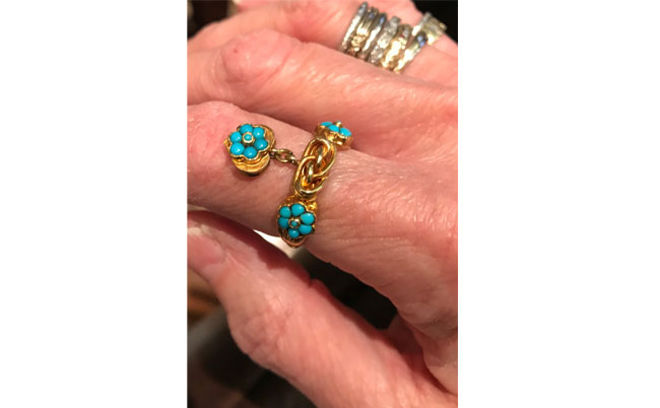From the Exhibition:
A View from the Jeweler’s Bench: Ancient Treasures, Contemporary Statements
Many pieces of jewelry embrace an intensely personal and intimate expression of identity that has invariably led to associations with strong emotions or significant personal events, and even a coded language where flowers, birds, knots, and a multitude of other motifs each had a meaning. Such jewelry could serve to convey messages from lovers, family, or friends, commemorate the birth of a child or significant event, serve as a souvenir, or a touchstone for grief. Jewelry that contains such codified significance has been labeled “sentimental.” Sentimental jewelry has been popular throughout history but was especially prevalent during the nineteenth century.1
Often sentimental pieces use symbolic language to communicate a message, and the Victorians in particular excelled and reveled in these coded messages. The Victorian forget-me-knot ring in the exhibition A View From the Jeweler’s Bench: Ancient Treasures, Contemporary Statements bursts with such symbols. Three turquoise forget-me-knot flowers form a striking composition: one of the flowers adorns the front of a hanging heart pendant while the other two flank an eternity knot. This grouping is held by two hands that wrap around the gold band of the ring. Together they broadcast a powerful message of everlasting love and friendship that would have been recognized not only by the maker, and the original wearer but also by anyone familiar with the symbolic language of jewelry.
The materials hold meaning in themselves. Turquoise was believed to be talismanic. In 1569 writer Edward Fenton said in his “Secrets of Nature” that turquoise would move if the wearer was in danger.2 By Shakespeare’s time turquoise’s power to protect was popularized to the point that it has been suggested that the playwright references this quality in Othello when Shylock mourns the loss of turquoise given to him by his wife Leah before they were married.3 Gold has been significant in many cultures across the globe, frequently bringing the wearer closer to the divine.
The motifs contained in this ring have a long history, the hands, and knots in particular can be traced back to the late Old Kingdom and Middle Kingdom in ancient Egypt respectively.4 The hand has been a potent talisman on its own and is frequently seen in amulet jewelry, where often the position of the fingers hold particular significance.5 Clasped hands on rings have held symbolic meaning since antiquity. During the Roman empire engagement rings frequently depicted two clasped hands to represent the sealing of a contract. Clasped hands continued to be a common motif for rings though it is unclear whether surviving historic examples are engagement rings or purely tokens of love. 6 These types of rings persist today and are now known as fede rings (a shortening of mani in fede, which means “hands clasped in faith” in Italian), given frequently as gifts of enduring love or friendship. Hands holding hearts are also common in this type of ring.
In the Victorian ring presented here, the hands offer up the turquoise forget-me-knot flowers, heart, and eternity knot. The meaning of these symbols goes beyond purely talismanic. Associated with eternal love, knots like this one have become known as “lover’s knots.” They were seen as being flexible and yet inseparable. If two ends of a knot are pulled it only gets tighter, a significant fact treasured during a time of frequent long separations in relationships with little means of communication.7 The forget-me-not flower was true to its name, expressing the desire that the wearer not forget someone, in this case probably the giver. 8 The heart symbolized love.9
Such treasures from the past are
highly valued today and finding an exceptional example such as this is often
elusive. When pieces of sentimental jewelry are worn by their modern
collectors, they accrue new meanings and stories like a fine patina. Beth
Bernstein, a discerning jewelry expert, generously loaned this ring from her
private collection, after having searched for a ring with this combination of
symbols for years (fig. 1). She considers it a rare prize that “had all the different meanings that
make up the sentimental jewelry that I love so much.”10

Sasha Nixon curated A View from the Jeweler’s Bench: Ancient Treasures, Contemporary Statements. She is a graduate of the master’s program, and the exhibition is based on the subject of her qualifying paper.
1.For further reading see Shirley Bury, Sentimental Jewellery (London: Victoria and Albert Museum Press, 1985). ↖
2.As cited in George Frederick Kunz, Rings for the Finger: From the Earliest Known Times to the Present, with Full Description of the Origin, Early Making, Materials, the Archaeology, History, for Affection, for Love, for Engagement, for Wedding, Commemorative, Mourning, Etc. (1917; New York: Dover, 1973), 220. ↖
3.Kunz, Rings for the Finger, 220. ↖
4.The Old Kingdom in Ancient Egypt is dated to 2686–2181 BC and the Middle Kingdom to 2055–1650 BC. Hugh Tait, ed., 7000 years of Jewelry (Buffalo: Firefly Books, 2008), 203. ↖
5.Ibid., 212. ↖
6.Ibid., 234–36. ↖
7.Bury, Sentimental Jewellery, 9–11. ↖
8.Beth Bernstein, “The Romantic Language of Flowers in Antique Jewelry,” The Jewellery Editor, August 10, 2015, http://www.thejewelleryeditor.com/jewellery/vintage/article/flowers-in-antique-jewellery-symbolism/. ↖
9.Beth Bernstein, “The Meaning and Symbolism of Heart Jewelry Throughout History,” Bejeweled Magazine, 2017, accessed March 10, 2019, https://www.bejeweledmag.com/have-a-heart/. ↖
10.Beth Bernstein, email conversation with the author, March 3, 2019. ↖
